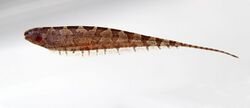Biology:Hypopomidae
| Hypopomidae | |
|---|---|

| |
| Steatogenys elegans | |
| Scientific classification | |
| Domain: | Eukaryota |
| Kingdom: | Animalia |
| Phylum: | Chordata |
| Class: | Actinopterygii |
| Order: | Gymnotiformes |
| Suborder: | Sternopygoidei |
| Superfamily: | Rhamphichthyoidea |
| Family: | Hypopomidae Mago-Leccia, 1978 |
| Genera | |
|
See text | |
The Hypopomidae are a family of fishes in the order Gymnotiformes known as the bluntnose knifefish. They may also be called grass or leaf knifefishes.[1] These electric fish are not often eaten, of little commercial importance, rarely kept as aquarium fish, and poorly studied; however, species in this family may constitute a significant fraction of the biomass in the areas they inhabit.[2]
These fish originate from fresh water in Panama and South America.[1] The Hypopomidae are confined to the humid neotropics, ranging the Río de la Plata of Argentina (35°S) to the Río Tuira of Panama (8°N). Hypopomids are known from the continental waters of all South American countries except Chile , and are most diverse in the Amazon Basin.[2]
Description
Teeth are absent on the oral jaws. Unlike the closely related Rhamphichthyidae, species of this family do not have a tubular snout, but a blunt, short one. Also, the nostrils are well separated. This family contains the smallest gymnotiforms, Microsternarchus brevis and Hypopygus hoedemani, which reach a maximum total length of 5.3 cm (2.1 in) and 5.9 cm (2.3 in) respectively.[3][4] Most other species in the family are also relatively small, less than 25 cm (10 in) long, although the largest, certain Brachyhypopomus, Hypopomus and Steatogenys, are up to 40–50 cm (16–20 in).[5] These fish have extremely small eyes — smaller in diameter than the distance between their nares. The long anal fin originates below or posterior to their pectoral fins, and no caudal fin is present.[2]
The electric organ discharge (EOD) of these fish are multiphasic (usually biphasic), and are produced in distinct pulses.[2] Certain predators, such as catfish and predatory knifefish, are able to detect these EODs and use this to their advantage in finding prey. However, species in the genus Brachyhypopomus restrict the low-frequency spectrum of their electric field close to their bodies, allowing higher frequencies to spread further; this makes it more difficult for predators to detect them.[6]
Taxonomy and genera
According to FishBase there are nine genera in this family,[2] but a molecular study in 2011 showed that one of these (marked with number sign# in list) should be subsumed into Hypopygus,[4] and a comprehensive molecular study from 2015 showed that two genera (marked with stars* in list) traditionally placed here belong in Rhamphichthyidae.[7] With these changes, six genera remain in the family Hypopomidae and this has been followed by recent authorities.[5][8][9]
- Akawaio[10]
- Brachyhypopomus
- Hypopomus
- Hypopygus*
- Microsternarchus
- Procerusternarchus[11]
- Racenisia
- Steatogenys*
- Stegostenopos#
References
- ↑ 1.0 1.1 Nelson, J.S. (2006). Fishes of the World. John Wiley & Sons, Inc.. ISBN 0-471-25031-7.
- ↑ 2.0 2.1 2.2 2.3 2.4 Froese, Rainer, and Daniel Pauly, eds. (2014). "Hypopomidae" in FishBase. November 2014 version.
- ↑ Cox Fernandes, C.; Nogueira, A.; Williston, A.; Alves-Gomes, J.A. (2015). "A new species of electric knifefish from the rio Negro, Amazon basin (Gymnotiformes: Hypopomidae, Microsternarchini)". Proceedings of the Academy of Natural Sciences of Philadelphia 164 (1): 213–227. doi:10.1635/053.164.0113.
- ↑ 4.0 4.1 de Santana, C.D.; W.G.R. Crampton (2011). "Phylogenetic interrelationships, taxonomy, and reductive evolution in the Neotropical electric fish genus Hypopygus (Teleostei, Ostariophysi, Gymnotiformes)". Zool. J. Linn. Soc. 163 (4): 1096–1156. doi:10.1111/j.1096-3642.2011.00736.x.
- ↑ 5.0 5.1 Field Guide to the Fishes of the Amazon, Orinoco, and Guianas. Princeton University Press. 2017. pp. 334–345. ISBN 978-0691170749.
- ↑ Stoddard, P.K.; Markham, M.R. (2008). "Signal Cloaking by Electric Fish". BioScience 58 (5): 415–425. doi:10.1641/b580508. PMID 20209064.
- ↑ Tagliacollo, V.A.; Bernt, M.J.; Craig, J.M.; Oliviera, C.; Albert, J.S. (2015). "Model-based Total Evidence phylogeny of Neotropical electric knifefishes (Teleostei, Gymnotiformes)". Mol Phylogenet Evol 95: 20–33. doi:10.1016/j.ympev.2015.11.007. PMID 26616344.
- ↑ Ferraris Jr, C.J.; C.D. de Santana; R.P. Vari (2017). "Checklist of Gymnotiformes (Osteichthyes: Ostariophysi) and catalogue of primary types". Neotrop. Ichthyol. 15 (1). doi:10.1590/1982-0224-20160067.
- ↑ "Catalog of Fishes". California Academy of Sciences. 12 May 2018. http://researcharchive.calacademy.org/research/ichthyology/catalog/fishcatmain.asp.
- ↑ Maldonado-Ocampo, J.A., López-Fernández, H., Taphorn, D.C., Bernard, C.R., Crampton, W.G.R. & Lovejoy, N.R. (2014): Akawaio penak, a new genus and species of Neotropical electric fish (Gymnotiformes, Hypopomidae) endemic to the upper Mazaruni River in the Guiana Shield. Zoologica Scripta, 43 (1): 24–33.
- ↑ Cox Fernandes C.; Nogueira A.; Alves-Gomes J.A. (2014). "Procerusternarchus pixuna, a new genus and species of electric knifefish (Gymnotiformes: Hypopomidae, Microsternarchini) from the Negro River, South America". Proceedings of the Academy of Natural Sciences of Philadelphia 163: 95–118. doi:10.1635/053.163.0107.
Wikidata ☰ Q577411 entry
 |

